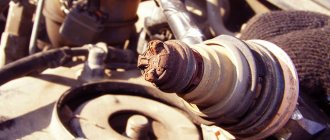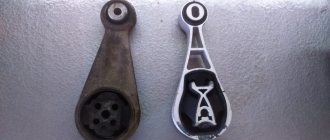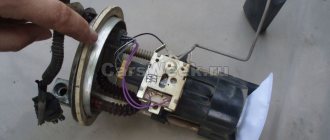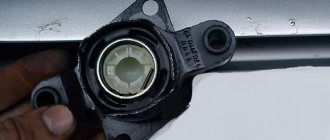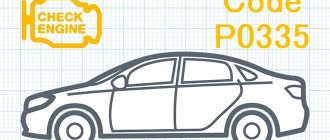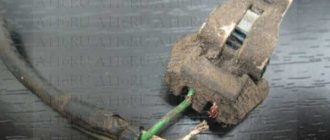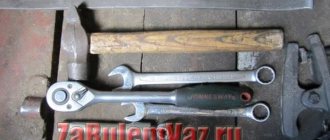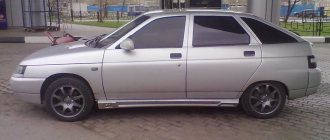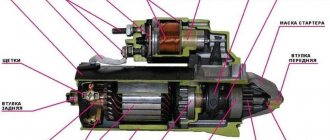Before checking anything, it is also necessary to understand the purpose of the part, which element may malfunction, and what symptoms the malfunction has. As you know, the engine is heavy and vibrates during operation. This means that if the internal combustion engine is rigidly attached to the car body, all vibrations will be transmitted to the car.
When driving over uneven places, the mounting points of the power unit experience significant loads. A rigid attachment to the body will mean that the fasteners and their installation location will quickly begin to break. To ensure that the overall design is reliable and comfort is maintained, special brackets are used to mount the internal combustion engine.
A cushion (engine support) is a part that serves to fix the power unit, prevents it from moving and dampens vibrations during operation. In fact, this is a real joint, only quite large. It is placed between the engine and the car body, that is, it is coupled to both the power unit and the body itself. The number of pillows depends on the make and model of the car; there are from three to five.
If you open the hood, you can immediately see the top (right bracket). The rest are located at the bottom of the engine. Again, locations vary by vehicle model, engine and transmission type. In most cases, engine mounts consist of a rubber casing and metal mounts.
Instead of rubber, polyurethane is sometimes used, which is more resistant to wear. On expensive cars, more complex and modern options are installed - hydraulic ones. The vibration damping efficiency is naturally much higher.
Such supports consist of two chambers, between which there is a membrane. Propylene glycol or a special liquid (gel) is used as a filler in the chambers. During operation, depending on road conditions (for example, potholes), it flows from one chamber to another through special channels, and the overall rigidity of the cushion dynamically changes due to this design.
There are different types of hydraulic supports:
- Electronically controlled. The computer changes the rigidity of the support by receiving and processing signals - vibrations, the strength of which varies depending on the situation. The liquid inside such a pillow often contains metal particles, and the density changes under the influence of a magnetic field. Thanks to such technologies, it is possible to achieve maximum comfort inside the car, regardless of engine operating mode and road conditions;
- With mechanical control. An easier option. Specifications are set during the assembly phase. It depends on them in what mode the maximum benefit will be: at idle or in different engine operating modes.
Of course, very expensive cars are equipped with high-tech devices. On budget options, and even more so on old Soviet models, simple rubber and metal fasteners are installed. In case of breakdown or wear (normally they last about 100,000 km), they are simply replaced. And the hydraulic system can be repaired. And even on your own. However, before removing the mounts, you need to know how to check the motor gel gasket, rubber, etc.
Device and diagnostics
The design of the hydraulic part of the motor mount is simple. Inside, under the rubber buffer of the main bearing (like a bearing without hydraulics), there are two compartments, located one above the other, filled with liquid. The chambers are separated by a rubber damping membrane wall, but also communicate with each other through a small hole - a throttling flow. At small vibration amplitudes, the membrane resists vibrations; at large amplitudes, channel overflow comes into play. Essentially, such a support has two “sub-ranges” in which it exhibits different damping characteristics.
Although the fluid in a failed mount is often black with rubber dust, the hydraulic portion of the mount rarely experiences physical wear; As a rule, the rubber block is the first to give in, losing its elasticity over time due to partial damage, metal delamination, micro-tears and cracks.
It is important to understand that the liquid and, in general, the entire hydraulic part in the rubber-hydraulic bearing still plays not the main role, but an auxiliary one. The mass of the engine, as in the case of conventional rubber-metal mounts, is supported by a powerful elastic rubber element. And if for some reason the liquid comes out of the support (which sometimes happens due to a rupture of the elastic bottom or due to a leak in the bearing of the housing parts), then there will be no catastrophe, except that the level of vibrations in the body increases. And it’s not a fact that even throughout the entire speed range, the defect is usually most noticeable at idle.
However, it is still not worth tightening it and replacing the support: the large amplitude of the engine’s swinging leads to the fact that when starting from a standstill or accelerating under load, it hits the stationary elements of the engine compartment, which can damage several tubes, hoses, and cables. And the rest, usually still quite alive, the supports begin to wear out intensively after the death of the main, hydraulic ones.
If you take the support by the working part (the one to which the support connecting it to the motor is screwed) and swing it (by the support in its pure form or by the motor itself), then you will not feel its “hydraulic “essence”. No, just the usual elasticity of rubber. Therefore, it is often impossible to visually detect faults in a rubber hydraulic cushion. Well, except for the cases when liquid is openly leaking from it... Both the new and dead bayonet react with some elasticity to manually applied force, inexperienced or at least in comparison with a similar machine with a well-known bayonet, it is difficult for a non-specialist to find the problem on his own, although This is not difficult for an experienced mechanic to do.
Therefore, to diagnose the serviceability of the airbag in garage conditions, it is necessary to observe the behavior of the caliper in near-working conditions, when the assistant accelerates under load (turning on the “D” mode or slightly releasing the clutch) on the hand brake). The amplitude of the engine swing and possible contact with the support of its support (body) is controlled by the central axial mount, which is unacceptable:
Repair of rubber-hydraulic bearings is not practiced. They are non-separable and spare parts for them are not sold. Although in workshops there is a practice of replacing supports with similar ones (we will not use the term “similar”) from other models and even brands of cars. The fasteners on the supports are redone: holes are re-drilled, adapter plates are made, etc.
In principle, when using mounts from another car with a motor of comparable power and weight, such tricks are generally feasible and are allowed out of desperation. Unless it is extremely undesirable to use transversely mounted cushions on longitudinally mounted engines, and vice versa, shear and compression loads for them are calculated completely differently, and such mounts do not work properly if installed incorrectly, do not dampen vibration, or are quickly destroyed.
Design features
A rigid engine mount contributes to the transmission of noise into the cabin and increases the load on the internal combustion engine parts, as the body inevitably “plays” on uneven surfaces. Therefore, vibration-absorbing materials are used in the design of the cushions. In modern automotive industry, various types of load-bearing structures are used:
- rubber gasket The blocks are attached to metal elements, between which there is a rubber layer. The silent blocks used in the car suspension are identical in design. This type of pillow is the most common, as it has a long resource and low production cost. Some types of rubber and metal bearings use springs to increase stiffness, as well as damping elements to reduce shock loads. Rubber alloy or polyurethane is used as shock-absorbing material;
- hydraulic cushion. The operating principle is close to the operation of shock absorbers. The design of the hydraulic mounts is more progressive, allowing the vibration damping to be adapted to the changing amplitude of vibrations from the engine and gearbox. The device assumes the presence of a working fluid, a membrane, an upper (working) and lower (expansion) chamber, as well as a throttling channel. At idle, the membrane dampens vibrations of the internal combustion engine. As the speed increases, the rigidity of the membrane becomes insufficient, so vibration damping begins to be carried out by hydraulic fluid. Thanks to this principle of operation, the cushion remains soft at idle, and changes in hardness only when the engine speed increases.
We will not consider the design of electrovacuum and electromagnetic engine mounts, since they are found only in luxury cars, where replacing an engine mount with your own hands is a phenomenon bordering on science fiction.
Where is the engine mount located and what does it look like?
The pads allow you to mount the engine to a subframe, rack or directly to the car body. The photo shows the main types of mounts, so even a novice motorist can find a mount for an internal combustion engine on his car by analogy. To securely fix the motor, use at least 3 pillows. The most common scheme is with three lower and two upper supports.
How do engine mounts work?
The cushions work similarly to the silent blocks of the suspension arms, that is, they twist the rubber. Therefore, in cars that drive mainly on bad roads, because such fastenings turn out to be unreliable, the rubber is multi-layered. More compact cars that have a relatively large weight (relative to the total weight of the car) are suspended somewhat differently: the rubber damper in them works in compression-tension, which increases their service life.
Also, these mounts fix the engine more rigidly, but the weak point of these mounts may be that the engine mount bracket is too long if it is solid and made of aluminum alloy. When the tires “sag,” careless driving on bad roads can lead to tire failure.
Hydraulic (or hydromechanical) engine mounts differ from conventional ones in that they have variable rigidity. This is achieved by vacuuming the engine. When a certain number of revolutions is reached, the valve separating the support chambers closes.
As a result, the liquid (antifreeze), which previously flowed from one chamber to another, begins to play the role of an elastic element. Externally, such mounts differ mainly in the presence of a fitting for connecting a vacuum hose and cable. Such cushions are designed to dampen vibrations from the engine, most of which “rest” against other mounts.
So, the owner believes that the engine mount has failed. Symptoms of malfunction confirmed. Next, you need to check the condition of the supports. To check the integrity of these parts, you will need a jack and any supports: wooden stumps, pallets, tires.
Anything will do. It is also advisable to prepare a mount or a thick stick. Let's figure out how to identify a faulty engine mount. To do this, it is recommended to place the car on the most level surface possible. Then the car must be jacked up, then a prepared stand must be installed under the engine. Maybe a magazine or something like that. It's better to remove the cat.
How to determine that the unit support has failed
Often, novice drivers do not know how to diagnose a faulty engine mount. Signs of such a breakdown are often confused with something else. The first signal that a support is broken is unpleasant sounds like clicking or knocking sounds in the front of the car when starting to move or when braking. Another sign is revealed when driving on uneven roads. Such a ride is necessarily accompanied by characteristic impacts in the front of the car. A sudden vibration can also indicate a malfunction of the airbag. Sometimes, when driving on bad roads, the gearshift lever may feel squeezing. This all indicates that there is a malfunction of the engine mount. These signs must be taken into account and then a diagnosis must be made. Sometimes it can be very difficult to determine if a support is broken. Typically, car enthusiasts attribute vibrations to the fact that the engine is not warm enough and often simply do not pay due attention to them. A characteristic sign that will tell you about the failure of a part is a creaking sound.
Signs and causes of engine mounting problems
The main signs of malfunction of engine mountings (mounts) are:
- strong vibration of the steering wheel when the engine is running;
- unevenness in the location where the gearbox is installed when driving over potholes;
- jerks in the transmission when driving and changing gears at high speed;
- knocking noises under the hood when overcoming uneven roads, as well as at idle and when the load changes while the engine is running;
When these signs appear, it is worth diagnosing the pillows. You can do this yourself.
Typical faults
If, while the car is moving, a characteristic knocking noise under the hood, more precisely under the bottom of the engine or in the transmission area, becomes clearly audible, if the noise and vibration intensify when switching from 2nd to 4th gear, then this may be due to problems with the suspension or engine operation. Depending on the condition of the road surface, these sounds may become louder.
If the car operates for a long time under conditions of significant loads or temperature changes, all this does not have the best effect on the condition of the engine mounts. Over time, rubber loses its elasticity. Also, the pillow may delaminate or crack, or even completely collapse.
But it is worth considering that the service life of these parts is quite long - more than 100,000 km. The fasteners experience heavy loads when starting the car and when braking. If the car owner likes to drive quite quickly, with sharp jerks at the start, the fastenings will not last the specified period.
Also among the typical malfunctions is the breakdown of a metal aluminum support. This often happens when driving through obstacles. If there is an oil leak from the engine, it will definitely get onto the rubber part of the mount. This lubricant can corrode the silent block and the mount will fail.
Also, the coolant does not have the best effect on the rubber part of the cushion. Faults in the system must be corrected immediately. Do not overheat the engine. In addition to the broken cylinder head, antifreeze from the expansion tank will also get on the rubber parts. This will not have the best effect on your resource.
Torn engine mount: signs
Like any other part, the power plant support also has a limited service life and eventually fails. On average, modern car airbags are designed to last at least 100-120 thousand kilometers, although in practice, replacement of these elements may be required either earlier or much later than this period.
Usually the cause of the problem is the rubber insert, which simply cracks and breaks under load. Less often, cracks appear in the metal part of the bracket, the installation sites of fasteners break, etc.
One way or another, the following symptoms usually indicate a malfunction of the engine mounts:
- The engine itself runs smoothly, but the driver feels a clear increase in vibrations in the body, on the steering wheel, on the gear shift knob, etc.;
- When starting off, as well as when braking, clicks or dull knocks are heard in the engine compartment;
- When driving on bad roads, knocking noises are heard from the front of the car; in many cases such knocking sounds are felt on the gear lever; shifting gears with a manual transmission can be difficult at this time;
To check the engine mounts, it is not necessary to immediately go to a service station and drive the car onto a stand. Usually the fault can be installed and localized yourself, even if you do not have too much experience in car repair and maintenance.
The simplest form of initial diagnosis is to rock the engine with your hands in the engine bay, after which you can locate the broken or cracked mount by tapping.
To make a more detailed check, you must first find out in advance where exactly the supports are located on a particular model. You will then need to preview the items available for your review. Cracks, tears and other damage are usually visible and easy to see.
To fully visually assess the lower airbags, you need to be prepared for the fact that you will have to park the car in a garage with an inspection hole, drive onto an overpass, or use an elevator.
If the surface diagnostic shows nothing, the wizard should be used again. One person moves the mount using a lever, and another person checks for breaks in the rubber insert as the mount moves. It happens that some cracks without clusters are not immediately visible.
As for the replacement itself, replacing the top cushion is quite simple. The car must be jacked up, the old cushion removed and a new one installed. If it is necessary to change the lower mounts, it is also important to take into account that after removing this cushion the engine will lower. This means that an additional support is needed that supports the internal combustion engine, allowing you to orient the pillow and correctly fix this element.
Signs of wear on engine mounts
- Engine vibration at idle.
- Strange irregularities while driving were felt in the engine compartment or under the gearbox.
- Jerks during dynamic acceleration of the car.
- Knocks in the engine compartment when starting or stopping the engine.
- Difficulty shifting gears.
In cars with hydraulic cushions, in addition, acceleration dynamics may deteriorate. Visually, defective pads can be identified by delamination and rupture of rubber shock absorbers or breakage of aluminum fasteners. A sagging pillow can also be detected by an experienced technician with the naked eye by how much the pillow is deformed.
Engine mount guards our comfort
What mission does this support carry? In essence, this is a fastening element that acts as an intermediary between the car body and the engine.
But this is not its only function, because if it was possible to organize direct fastening of the power unit to the car frame, then the designers could get by with ordinary bolts. But this is absolutely impossible to do.
The fact is that the engine itself is quite heavy, but sensitive to sharp impacts; in addition, during operation it vibrates, which would be transmitted throughout the body, and we would feel like we were in the aforementioned airplane. Therefore, in order to protect the engine itself, as well as our comfort, the designers have developed special elements - engine mounts or, in other words, cushions.
Checking engine mounts yourself
Making such a diagnosis is not at all difficult. Even if the car uses hydraulic cushions. The main thing is to know how to properly check the correctness of the engine mount, as well as diagnose the rest. This can be done in several ways, which are best used together to make a more accurate diagnosis.
- The first method is good for hydraulic supports. After the car is placed on a flat surface, you need to open the hood and start the engine. Then try moving around a little.
With faulty cushions, the motor will move out of its place. In this case, characteristic sounds will be clearly audible. A similar check can be done with the engine not running by inserting a pry bar or stick between the engine and the car body and trying to rock the power unit from side to side.
- The second way to check is this. With the engine running, you should put it in gear and back away a few inches. In different types of gearboxes, when the airbag malfunctions, characteristic shocks may be felt.
- To check the bottom brackets you will need a hatch, a jack and a wooden platform about two feet high. After jacking up one wheel and replacing the jack with a platform, you need to inspect the bottom of the cushion for cracks, tears, or hydraulic fluid leaks. Of course, before this it is necessary to take safety measures to prevent the car from moving from its place (anti-reverse locking of the rear wheel, etc.).
In order for the supports to last as long as possible, you need to monitor your driving style. The principle of “higher speed, fewer holes” must be thrown out of your head forever. Also, engine mounts are more likely to fail if the engine is started frequently and harshly. In a word, the fewer sharp fluctuations of the internal combustion engine, the less often you will have to check the condition of the engine mounts.
Checking rubber-metal engine mounts
The first method, which will help determine the malfunction, is the simplest, but the least informative. You open the hood, ask the assistant to start the engine, and then slowly drive away, drive literally 10 centimeters, then put the car in reverse and reverse. If the engine changes position as a result of changing vehicle driving modes, or vibrates too much, the problem is most likely in the airbags. This method is most suitable for checking the right, also known as the upper engine mount, which is clearly visible under the hood. However, several pillows or a problem with the carriage may fail at once, so it’s worth moving on to the next option.
The second method will help check the integrity violation and check the condition of all pillows. It will require a hole or overpass, a jack, a support or support, a support or a strong lever. The following is the algorithm.
- Raise the front of the car using a jack (if it has a rear engine, then rear).
- Support the raised vehicle with jacks or a stand/block.
- Use the released jack to support the engine and remove its weight from the mounts.
- Inspect the engine mounts for damage.
Visual inspection of the rubber-metal support
What can you see when looking at them? Traces of destruction or damage to the structure, ruptures, cracks, peeling of the rubber layer, peeling of rubber from the metal part. During inspection, special attention should be paid to the junction of rubber and metal.
If the visual inspection does not produce results, then another procedure must be performed. Have a helper take a pry bar or pry bar and move the motor a little around each pad. If there is noticeable play at the mounting location, you just need to tighten the mounting brackets. Or by such actions you will be able to identify the separation of the rubber-metal support from its metal part.
How to check engine mounts on a VAZ
If we talk about the most popular VAZ cars, for example, model 2170 (Priora), then all the pillows are ordinary, rubber and metal. Even the modern Lada Vesta does not use hydraulic supports. Therefore, for VAZs, only an external inspection of the airbags described above is relevant, however, only in the case of installing standard mounts, and not retrofitting, since there are alternative options from third-party manufacturers, or airbags that fit other cars from time to time. For example, on Vesta, as a replacement for the original right airbag (part number 8450030109) on the E46 body, a hydraulic support from BMW 3 (part number 2495601) is used.
Characteristic features of the “dead” VAZ engine mounts are:
- too strong and sudden jerks of the engine;
- The flywheel jerks at high speeds;
- shift gears while driving.
How to check the right, rear, front, left engine mounts
Depending on the design of the car, the airbags can be installed in different places. For example, on VAZ 2110-2112 cars, the top (known as the “guitar”), right and left side supports, as well as rear airbags are used. Most Mazda vehicles have right, left and rear mounts. Many other cars (eg Renault) have: right, front and rear.
Most often, it is the correct airbag that is installed on the roof of the car, so it can also be called the top one. Therefore, the first test method, without a hole, is most suitable for the right (upper) support. The second method is for the front and rear blocks under which the engine is mounted.
Separately, we note the peculiarity that in different car models, not all pillows can be of the same type. It usually happens that the supports are hydraulic in the upper part and rubber-metal in the lower part. On expensive cars, all fastenings are hydraulic (they can also be called gel). You can check them in ways that will be described below.
Checking the engine hydraulic mount
The method of accumulation and vibration of the engine during startup is also relevant for checking hydraulic cushions (gel), but it is still worth inspecting your body for hydraulic fluid leaks. You need to look both at the top of the support, where there are technological holes, and at the bottom, where it can wear out. This applies to all hydraulic cushions, both mechanically and electronically vacuum controlled.
Failed hydraulic cushions are much easier to identify than conventional ones. If you don’t notice engine jerks, knocking noises, vibrations in the body when starting, going over bumps and going over bumps, you won’t be able to return to the gear lever. It is also easier to detect play in the vertical and horizontal directions when loosening a raised engine using a bracket.
The simplest method by which you can check the serviceability of the right upper hydraulic spring is to put the car on the parking brake and give it more gas. Any driver can notice engine deviations and racing in support.
The following method is suitable for vehicles with hydraulic engine mounts on vehicles with automatic transmission. You will need a smartphone with vibration measurement software installed (for example, Accelerometer Analyzer or Mvibe). First, turn on driving mode. Then look at the screen to see if the vibration level has increased. Then do the same in reverse. Determine in which mode the engine vibrates more than normal. Then have a helper take the wheel while you look at the engine. Let him turn on the mode in which the vibrations intensify. Pay attention to which direction the engine is currently lowering - it is this cushion that is damaged.
Another test method is suitable for vehicles with exclusively hydraulic mounts that use electronically controlled vacuum cushions. To do this, you need to start the engine, and it is better to open the oil filler cap so that the engine knock can be heard more clearly. Next you need to find the vacuum hoses that go to each of the pillows. The right one is usually accessed from above by simply opening the hood (as in this video). Remove the hose from the pillow and hold it with one finger; If the lump goes away, then there is a gap in the pillow and there is depressurization, and that’s why it hits.
What is needed for this
Use a hydraulic jack or other
To check you will need:
- hydraulic or other jack you have;
- some kind of safety support, like a wooden block or something else;
- Digging: A pry bar or a strong stick works well for this.
Check procedure
Pillow review
- Drive the car with the previously removed guards into a garage or onto a level area.
- Raise the car by placing a jack under one of the front wheels (and if it has a rear engine, then behind it.
- Position the existing mount under the engine to relieve stress on the engine mount. After making sure the bracket is secure, lower the jack.
- Using a slide or something else, get under the car and begin to inspect the condition of the engine mounts.
Visually you can find:
- cracks and tears in rubber;
- that the tires are dull;
- pillow compartment.
Damaged engine mounts
However, it may turn out that you did not visually detect any of the possible problems. In this case, you can try experimenting with the attachment points of the engine mounts to the body or front beam of the car. To do this, just tilt the motor in different directions, using a stick/bracket as a lever. If no kickback is detected, rest assured that the engine mounts are fine.
If there is play, and especially if it is noticeable (the engine swings noticeably from side to side), it will need to be removed. To do this, you need to reinstall the jack and raise the car, then remove the safety stand under the engine. Check that the motor mount is securely fastened. If not, tighten it with a wrench or ratchet.
Features of the procedure for replacing motor mounts
It is necessary to ensure free access to the cushions, so in addition to the keys, you will also need a solid jack. Let's look at the list of measures to replace a faulty cushion using the example of a rubber-metal product:
- Loosen the nut that secures the cushion to the body.
- Raise the engine and remove the bolt.
- Unscrew and remove the faulty support.
- We install a new one and tighten it.
- Raise the engine, insert the mounting bolt.
- Tighten the bolt and lower the engine.
Note! If vibration, on the contrary, increases after installing new cushions when the car is warmed up and running, then the fasteners must be centered. To do this, loosen all the pillow mounting bolts and tighten evenly until the vibration stops.
Self-replacement
If a visual inspection reveals problems with the cushion, it should be replaced as soon as possible. Start by purchasing a new part. It should be noted that it is better not to buy this part disassembled, even if it is in good condition. In this case, saving money may do more harm than good. The ideal would be to buy an original part.
- Remove the battery terminals. Raise the vehicle to a height that allows access to the engine from below. In this case, you can use a jack and wooden beams for support.
- Raise the engine with a jack to free it from the load of the required part.
- Remove the bolts that secure the cushion to the engine and body.
- Reinstall the new part, oriented correctly. Tighten the mounting screws thoroughly. It's best to tighten them while the engine is running to avoid excessive vibration in the future.
- When you have finished installing the cushion, replace any parts you removed.
In each case, there may not be easy access to replace the part. In this case, try removing those nodes that prevent you from replacing.
Sometimes this operation may require another person to help guide the motor while you push the part into place. If we are talking about the top cushion, then, as a rule, it is not difficult to inspect it and, if necessary, replace it. It will be possible to do without a hole.
Periodically check the condition of your vehicle's engine mounts. As you can see, this is not at all difficult, but it will help you avoid many problems in the future and give you a comfortable ride in any conditions. Remember that a car feels when it is taken care of and then thanks its owner for a long and good service.
How to remove and change the front and rear supports of a VAZ 2109
Front support
First, let's look at the sequence of replacing the front support, and then the rear. To change the front support, it is not necessary to drive the car into the inspection hole, you just need to have the following set of tools: a set of various sockets, spanners, sockets and the corresponding ratchet, a wrench, a jack, a special liquid for cleaning metal from corrosion and a new part.
Procedure:
- Before carrying out work, it is necessary to place the car on a level surface, immobilize it and remove the terminal from the battery. After this, treat the bolted joints with WD-40. This will make disassembling the connections easier.
- Under the car, locate and unscrew all the engine protection bolts. It is not necessary to remove all the elements; it is enough to unscrew only the part that blocks access to the mudguard and pan. After this, loosen the bolts connecting the engine support parts.
- Raise the engine with a jack until the bolt in the support begins to move freely. After this, unscrew the nut completely and remove the bolt from the cushion. If it is bent and does not give in, then you can use impact tools and knock it out from the back side.
- Once the cushion is free, unscrew the bracket bolts that secure it to the cylinder block. Next, the old support is dismantled and a new part is installed in its place in the reverse order. When installing a new support, the hole in the pad may not line up. This is an absolutely normal phenomenon, since the engine pressed the old part sufficiently and it became deformed. Use a jack to adjust the installation height.
Rear support
To replace the rear support, it is recommended to use a hole or overpass, since working under the car while lying down is quite inconvenient and dangerous.
- First of all, it is necessary to install some kind of support or jack under the gearbox so that it does not move in the future. The support must be strong, since a rather impressive mass will act on it.
- Using a 17mm socket, you need to unscrew the two nuts that are designed to secure the support bracket to the car body. After this, the stop or jack is lowered slightly, and using a 19 socket and a wrench, the mounting of the cushion on the gearbox is unscrewed.
- Using an impact tool, remove the thick bolt and remove the old cushion. After this, install a new support and secure it to the gearbox. Then, lift the support or jack and screw the nuts securing the support to the car body. Tighten with sufficient force, since poorly tightened nuts can cause the power unit to sag again and cause rapid wear of the fastening devices.

